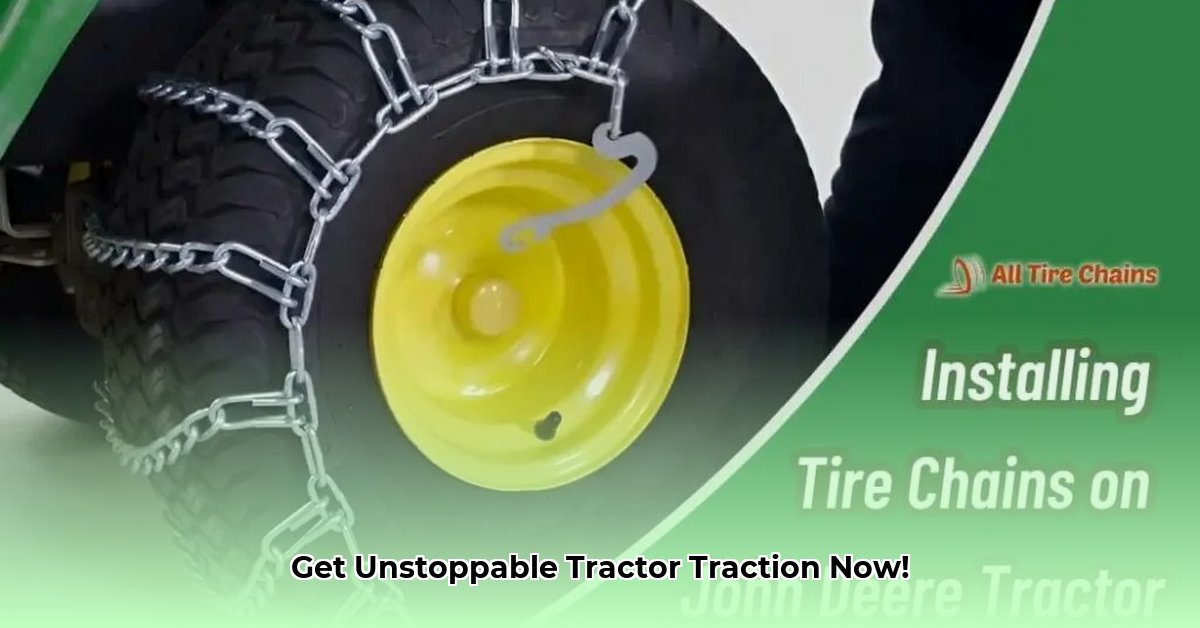
Winter's icy grip can significantly reduce traction, potentially halting your farm operations. Equipping your tractor with tire chains provides crucial enhanced traction on snow and ice, ensuring continued productivity. For more information on tractor tire types, check out this helpful resource: tractor tire guide. This step-by-step guide provides clear instructions and safety precautions for effective chain installation.
Gearing Up: Essential Tools and Materials
Before you begin, gather the necessary tools and materials. Having everything readily available ensures a smooth, safe installation process. You will need:
- Tractor Tire Chains: Ensure compatibility with your tractor's tire size. Incorrect sizing is unsafe and ineffective. Consult your tractor manual or a farm supply store for assistance.
- Work Gloves: Protect your hands from potential abrasions caused by the chain's rough texture.
- Chain Installation Tool (Optional but Recommended): This specialized tool simplifies chain tightening and connection, minimizing effort and increasing safety.
- Wheel Chocks: Absolutely crucial for safety, preventing accidental tractor movement during installation. Securely wedge them against the wheels.
- Jack (Possibly): Depending on your tractor, a jack may facilitate easier chain placement by slightly raising the wheel.
Installing Tractor Tire Chains: A Step-by-Step Guide
Safety is paramount. If unsure about any step, consult a mechanic or experienced tractor user. Remember, a moment of caution can prevent serious accidents.
Prioritize Safety: Secure the Wheels: Begin by firmly applying wheel chocks to each wheel, preventing unwanted movement. This single act dramatically reduces the risk of accidents. Double-check their placement – safety is non-negotiable.
Prepare the Chains: Lay the tire chains flat on the ground beside the wheel. This organized approach minimizes tangles and provides a clear view of the chain’s layout for easier handling. This step is crucial as it creates efficiency in the subsequent actions.
Attaching the Chains: Carefully drape the chain around the tire, ensuring correct alignment as indicated by any markings on the chains. Connect the chain's hook ends, ensuring a secure, tight connection. A loose connection compromises traction and safety.
Tighten Using the Cross-Chain Method: Most chains use a cross-chain design for even pressure distribution. Tighten the chains, aiming for a snug fit without over-tightening, which can damage the tire. Utilize a chain installation tool if available; this tool significantly simplifies this crucial step.
Inspect the Fit: Once tightened, meticulously examine each chain link for security and absence of pinching or binding. The chains should lie evenly against the tire surface, free from excessive looseness or tightness. A thorough visual check is essential.
Test and Adjust: Manually rotate the wheel to verify that the chains don't bind or rub against the tractor frame. If interference occurs, loosen, reposition, and re-tighten the chains until the wheel turns freely, preventing potential damage.
Final Safety Check: Before operation, conduct a complete inspection. Re-check for loose links, uneven tension, or potential rubbing points. This crucial final step guarantees safety and optimal performance.
Troubleshooting Common Installation Issues
Unexpected challenges may arise. Here are solutions for common problems:
- Chains Too Tight: Loosen the chains to avoid tire damage. Over-tightening is a frequent problem and should be avoided.
- Chains Too Loose: Re-tighten the chains to ensure adequate traction. Loose chains negate their intended performance.
- Chains Rubbing Against the Frame: Reposition the chains for proper clearance to avoid damage to both chains and the tractor. Careful repositioning is key to prevention.
The Importance of Regular Maintenance
Prolonging the lifespan of your tire chains requires regular maintenance. After each use, inspect for damage and properly store the chains in a clean, dry location. This simple act significantly contributes to their longevity and cost-effectiveness.
Remember, tire chains significantly enhance safety and productivity in challenging conditions. By following these steps and prioritizing safety, you'll navigate winter's obstacles with confidence.